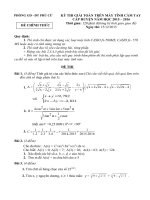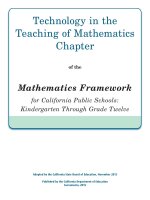- Trang chủ >>
- Mầm non - Tiểu học >>
- Lớp 1
Addition made easy (making math easy)
Bạn đang xem bản rút gọn của tài liệu. Xem và tải ngay bản đầy đủ của tài liệu tại đây (7.08 MB, 50 trang )
Wingard-Nelson
Addition
Made Easy
For more information about this series, go to
_
Addition Made Easy
Multiplication Made Easy
0-7660-2508-X
0-7660-2510-1
Division Made Easy
Subtraction Made Easy
0-7660-2511-X
0-7660-2509-8
Fractions and Decimals Made Easy
Word Problems Made Easy
0-7660-2513-6
0-7660-2512-8
ADDITION MADE EASY
Do you wish someone could simply explain addition? Well, ask no
more! This book covers topics such as one-digit, two-digit, and threedigit addition. Learn about partial sums, regrouping, and place value.
Whether you are learning this information for the first time—on your
own or with a tutor—or you would like to review your math skills, this
book is a great choice.
About the Author
Rebecca Wingard-Nelson has worked in public, private, and home-school
mathematics education. She has been involved in various educational math
projects, including developing and writing state assessment tests, exit exams,
and proficiency tests, as well as writing and editing textbooks and workbooks.
REINFORCED LIBRARY BINDING
Rebecca Wingard-Nelson
ENSLOW
ISBN 0-7660-2508-X
Illustrated by Tom LaBaff
This page intentionally left blank
Addition
Made Easy
Rebecca Wingard-Nelson
Enslow Elementary, an imprint of Enslow Publishers, Inc.
Enslow Elementary® is a registered trademark of Enslow Publishers, Inc.
Copyright © 2005 by Enslow Publishers, Inc.
All rights reserved.
No part of this book may be reproduced by any means without the written permission
of the publisher.
Library of Congress Cataloging-in-Publication Data
Wingard-Nelson, Rebecca.
Addition made easy / Rebecca Wingard-Nelson.
p. cm. — (Making math easy)
Includes index.
ISBN 0-7660-2508-X (hardcover)
1. Addition—Juvenile literature. I. Title.
QA115.W75 2005
513.2'11—dc22
2004021657
Printed in the United States of America
10 9 8 7 6 5 4 3 2 1
To Our Readers: We have done our best to make sure all Internet Addresses in this
book were active and appropriate when we went to press. However, the author and the
publisher have no control over and assume no liability for the material available on those
Internet sites or on other Web sites they may link to. Any comments or suggestions can
be sent by e-mail to or to the address on the back cover.
Illustrations: Tom LaBaff
Cover illustration: Tom LaBaff
Contents
Introduction
Numbers and Place Value
Adding One-Digit Numbers
Addition Terms
Column Addition
What Is Regrouping?
The Zero Property
The Commutative Property
The Associative Property
Adding Two-Digit Numbers
Regrouping and Carrying
Adding Thre e-Digit Numbers
Regrouping for Thre e Digits
Adding Greater Numbers
Partial Sums
Rounding to Estimate
Mental Addition
Adding Money
Adding Time
Addition Key Words
Word Problems
Further Reading
Internet Addresses
Index
5
6
8
10
12
14
16
18
20
22
24
26
28
30
32
34
36
38
40
42
44
46
47
48
4
Introduction
M
ath is all around, and an important part of
anyone’s life. You use math when you’re
playing games, cooking food, spending money,
telling time, reading music, or doing any other
activity that uses numbers. Even finding a television
channel uses math!
Addition Is Everywhere
Every day you use addition, and you might not even
know it. When you have one sticker, and your friend
gives you one more sticker, you know that you have
two stickers. Addition is that simple.
Using This Book
This book can be used to learn or review addition
at your own speed. It can be used on your own or
with a friend, tutor, or parent. Get ready to
discover math . . . made easy!
5
Numbers and
N
umbers are written using the following ten
symbols, called digits.
0, 1, 2, 3, 4, 5, 6, 7, 8, 9
Numbers zero through nine are written using only
one digit. Larger numbers are written using two or
more digits.
The number 346 has three digits, each in a different
place. Each place has a name that tells its value.
6
tens
ones
hundreds
Place Value
d igit—A symbo
l
that stands fo
r
a number.
346
In the number 346, the digit 6 is in the ones
place. That means the digit has a value of 6 ones.
The digit 4 is in the tens place. It has a value
of 4 tens.
The digit 3 is in the hundreds place. It has a value
of 3 hundreds.
3 hundreds (300) ϩ 4 tens (40) ϩ 6 ones (6)
346
7
Adding OneT
he one-digit numbers are
0, 1, 2, 3, 4, 5, 6, 7, 8, and 9.
When you add two numbers together, you find how
many you have in all. If you have one soccer ball
and add two soccer balls, you have three soccer balls
in all.
ϩ
1
2
ϭ
3
Let’s try another one. If you have four blue marbles
and then get two more red marbles, you have six
marbles in all.
4
8
ϩ
2 ϭ
6
Digit Numbers
All of these equations have one-digit answers.
0ϩ0ϭ0
2ϩ2ϭ4
4ϩ3ϭ7
0ϩ1ϭ1
2ϩ4ϭ6
4ϩ4ϭ8
0ϩ3ϭ3
2ϩ5ϭ7
5ϩ0ϭ0
0ϩ4ϭ4
2ϩ7ϭ9
5ϩ1ϭ6
0ϩ7ϭ7
3ϩ1ϭ4
5ϩ3ϭ8
1ϩ1ϭ2
3ϩ3ϭ6
5ϩ4ϭ9
1ϩ3ϭ4
3ϩ4ϭ7
6ϩ0ϭ6
1ϩ4ϭ5
3ϩ5ϭ8
6ϩ2ϭ8
1ϩ6ϭ7
3ϩ6ϭ9
7ϩ2ϭ9
2ϩ0ϭ2
4ϩ0ϭ0
8ϩ1ϭ9
When you learn how to add one-digit numbers,
adding larger numbers is easy.
9
Addition
A
ddition problems can be written two ways,
in a line or in a column.
line
4ϩ3ϭ7
plus sign
equal sign
column
4
ϩ3
7
“equals”
plus sign
When you read an addition problem out loud, you say,
4 ϩ 3 ϭ 7
Four plus three equals seven.
10
Terms
Numbers that are being added are called addends.
6
ϩ3
9
addend
addend
The answer to an addition problem is called the sum.
1
ϩ4
5
sum
11
Column
Y
ou can add three or more numbers. Put the
numbers under each other in a column. This is
called column addtion.
1ϩ4ϩ2
Write the numbers in a column.
1
4
ϩ2
Add any two of the numbers.
1
4
ϩ2
1ϩ4ϭ5
Now add the third number to the sum you just found.
1
4
ϩ2
7
5
The sum of 1 ϩ 4 ϩ 2 is 7.
12
5ϩ2ϭ7
Addition
Add any two
numbers first.
The answer w
ill
be the same.
In column addition, just keep
adding numbers. When there are
no more numbers to add, you are done!
Look at another example.
3ϩ2ϩ3
Write the numbers in a column.
3
2
ϩ3
8
Add two of the numbers.
3ϩ2ϭ5
Add the third number.
5ϩ3ϭ8
13
What Is
W
hen you add numbers, sometimes the answer
is more than 9. You can regroup! Regrouping
changes a group of 10 ones into 1 ten.
ϭ
10 ones
Let’s look at
1 ten
6 ϩ 6.
ϩ
ϭ
6 ones ϩ 6 ones
ϭ
12 ones
The sum of 12 ones can be regrouped as 1 group of
ten with 2 ones left over.
tens
ones
ϭ
12
14
The number 12 has a 1 in the tens place
and a 2 in the ones place.
Regrouping?
tens
ones
7 ϩ 8
tens
ones
7
ϩ8
15
9
ϩ 1
10
7 ones ϩ 8 ones ϭ 15 ones
You can’t write 15 ones in the ones
place. There is only room for one digit
in the ones place.
Regroup 15 ones as 1 ten and 5 ones.
Write a 5 in the ones place. Write the
1 in the tens place.
9 ϩ 1
In column add
ition,
always add fr
om
right to left.
9 ones ϩ 1 one ϭ 10 ones
Regroup 10 ones as 1 ten and 0 ones.
There are no ones! The number 0 is
used as a placeholder to show that
there are no ones after regrouping.
Write the 0 in the ones place. Write
the 1 in the tens place.
15
The Zero
T
he number zero means “nothing” or “none.”
Any number plus zero (0 ) equals the number.
This is called the zero property of addition.
If you have five pigs and
you get zero more (none),
you still have five pigs.
5ϩ0ϭ5
If you start with zero pigs
(none) and get five,
you have five pigs.
0ϩ5ϭ5
16
Property
The Zer o Pr o
perty—
0 ϩ number
ϭ
number
The zero property of addition is
always true, no matter how large
the number is that you are adding with zero.
1
ϩ0
1
0
ϩ9
9
12
ϩ 0
12
0
ϩ 26
26
99
ϩ 0
99
102
ϩ 0
102
891
ϩ 0
891
0
ϩ 1,243
1,243
1,204,612
ϩ
0
1,204,612
17
The Commutative
Y
ou can use the same numbers to make
different addition problems. Let’s try the
numbers 4 and 5.
4ϩ5ϭ9
5ϩ4ϭ9
When the numbers being added change places,
the answer stays the same. This is called the
commutative property of addition.
You can remember the name of the property by
knowing that when you commute, you to go back
and forth, or change places.
Let’s look at another one.
7 ϩ 6 ϭ 13
The sums are
the same.
6 ϩ 7 ϭ 13
18
Property
When you know the sum of 3 + 4,
you also know the sum of 4 + 3.
3ϩ4ϭ7
4ϩ3ϭ7
The Commuta
tive
Pr operty—
When adding
any
two numbers,
the
order in whic
h
you add them
does
not change th
e
answer.
The commutative property of addition is always true,
no matter what numbers you are adding.
2
ϩ1
3
1
ϩ2
3
14
ϩ 5
19
5
ϩ 14
19
19
The Associative
S
ometimes you need to add three or more
numbers. You can use parentheses to show
which two numbers get added first.
1ϩ2ϩ4
(1 ϩ 2) ϩ 4 says that 1 and 2 are added first.
Add inside the parentheses.
(1 ϩ 2) ϩ 4
3
Now add the third number.
3ϩ4ϭ7
So, (1 ϩ 2) ϩ 4 ϭ 7
Watch what happens when the parentheses are
put around a different set of numbers in the
same problem.
20
Property
1 ϩ (2 ϩ 4)
says that 2 and
4 are added first.
Add inside the parentheses.
T he A s s o cia ti
ve
Pr op e r ty —
When adding
thre e
or more num
bers,
the way you
group,
or associate,
the
numbers does
not
change the an
swer.
1 ϩ (2 ϩ 4)
6
Now add the third number.
1ϩ 6ϭ7
So, 1 ϩ (2 ϩ 4) ϭ 7
The answer did not change when the numbers
were grouped in a different way. This is called the
associative property of addition.
You can remember the associative property by
knowing that associates are partners. In addition,
you can associate or partner the numbers
together in any way you choose.
21
Adding TwoW
tens
ones
rite two-digit addition problems in columns.
Line up the numbers so that the same place
values are in the same column.
13
ϩ 24
13 + 24
13 is the same as 1 ten and 3 ones
24 is the same as 2 tens and 4 ones
1 ten
3
2 tens
4
13
24
Always add from right to left. First, add the
numbers in the ones column. Write the answer in
the ones place.
13
ϩ 24
7
22
3ϩ4ϭ7
Digit Numbers
Add the numbers in the tens column. Write the
answer in the tens place.
13
ϩ 24
37
1ϩ2ϭ3
Let’s look at another one.
42 + 36
42
ϩ 36
Add the
ones.
42
ϩ 36
8
Add the
tens.
42
ϩ 36
78
23









